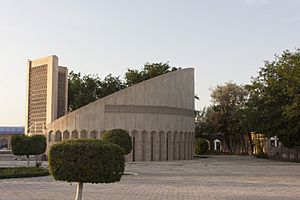Muhammad al-Bukhari facts for kids
Quick facts for kids Muḥammad ibn Ismā‘īl al-Bukhārī |
|
|---|---|
| محمد بن إسماعيل البخاري | |

al-Bukhārī's name in Arabic calligraphy.
|
|
| Religion | Islam |
| Denomination | Sunni |
| Personal | |
| Born | 21 July 810 C.E. 13th Shawwal 194 A.H. Bukhara, Abbasid Caliphate |
| Died | 1 September 870 (aged 60) C.E. 1 Shawwal 256 A.H. Khartank, Samarkand, Abbasid Caliphate |
| Resting place | Khartank (Samarkand, Uzbekistan) |
| Senior posting | |
| Title | Imam al-Bukhari Amir al-Mu'minin fi al-Hadith |
| Influenced | Muslim ibn al-Hajjaj Ibn Abi Asim |
| Imam al-Bukhārī | |
|---|---|

Imam al-Bukhārī's mausoleum near Samarkand, Uzbekistan
|
|
| Hadith Traditionalist | |
| Venerated in | Sunni Islam |
| Major shrine | Khartank (Samarkand, Uzbekistan). |
Muḥammad ibn Ismā‘īl al-Bukhārī (Persian: بخاری) (born July 19, 810 – died September 1, 870) was a very important Persian Islamic scholar. People often call him Imam al-Bukhari or Imam Bukhari. He was born in Bukhara, a city in what is now Uzbekistan.
Imam Bukhari is famous for putting together a collection of hadith called Sahih al-Bukhari. Hadith are sayings and actions of the Prophet Muhammad. Sunni Muslims consider this book to be the most reliable collection of hadith. He also wrote other books, like Al-Adab al-Mufrad.
Contents
Biography of Imam Bukhari
His Early Life
Muhammad ibn Ismaʿil al-Bukhari was born on Friday, July 21, 810 CE. This was in the city of Bukhara, in a region called Transoxiana. Today, this area is part of Uzbekistan.
His father, Ismail ibn Ibrahim, was also a scholar who studied hadith. He was a student of a famous scholar named Malik ibn Anas. Imam Bukhari's father passed away when he was very young. So, his mother raised him.
His Family Background
Imam Bukhari's great-grandfather, al-Mughirah, moved to Bukhara. He became a Muslim there. His family then became known by the name "al-Juʿfi."
Most historians say that Bardizbah was Imam Bukhari's earliest known ancestor. Bardizbah followed the Zoroastrian religion. Not much is known about Bardizbah or his father, Bazzabah. They were Persian and followed their people's religion.
His Hadith Studies and Travels
Imam Bukhari started studying hadith when he was very young, around 15 years old. He memorized many important books even as a child. He traveled with his mother and brother to learn more.
A historian named al-Dhahabi wrote about Imam Bukhari's early studies:
He began studying hadith in the year 205 (A.H.). He memorized the works of [‘Abdullah] ibn al-Mubaarak while still a child. He was raised by his mother because his father died when he was an infant. He traveled with his mother and brother in the year 210 after having heard the narrations of his region. He began authoring books and narrating hadith while still an adolescent. He said, “When I turned eighteen years old, I began writing about the Companions and the Followers and their statements. This was during the time of ‘Ubaid Allah ibn Musa (one of his teachers). At that time I also authored a book of history at the grave of the Prophet at night during a full moon.
When he was sixteen, he went on a pilgrimage to Mecca with his brother and mother. From Mecca, he began many journeys to learn more about hadith. He visited all the important centers of Islamic learning. He spoke with many scholars and shared information about hadith. It is said he heard from over 1,000 teachers. He learned more than 600,000 traditions.
After sixteen years away, he returned to Bukhara. There, he wrote his famous book, al-Jami' as-Sahih. This book contains 7,275 carefully checked hadith. They are arranged in chapters to help understand Islamic law.
His book is highly respected by Sunni Muslims. It is seen as the most reliable collection of hadith. Many scholars believe it is second in importance only to the Quran. He also wrote other books. These include al-Adab al-Mufrad, which is about good manners and ethics.
His Later Years
In 864 CE, Imam Bukhari settled in a city called Nishapur. There, he met Muslim ibn al-Hajjaj, who became his student. Imam Muslim later compiled his own hadith collection, Sahih Muslim, which is considered very important after al-Bukhari's work.
Later, due to some disagreements, Imam Bukhari moved to Khartank. This was a village near Samarkand. He passed away there in 870 CE.
Imam Bukhari's Mausoleum
Today, Imam Bukhari's tomb is in the Imam al-Bukhari Complex. It is in Hartang Village, about 25 kilometers from Samarkand. The complex was restored in 1998 after many years of not being cared for.
The mausoleum complex has Imam al-Bukhari's tomb, a mosque, a religious school (madrassah), and a library. There is also a small collection of Qurans. The tombstone you see today is a memorial. His actual grave is in a small burial room below.
His Writings
Imam Bukhari wrote several important books. Here are some of his main works:
Books About Hadith Narrators
Imam Bukhari wrote books that talked about the people who shared hadith stories. He checked how good they were at telling these stories.
- Al-Tarikh al-Kabīr (The Great History): This is a large book. He also wrote a medium and a brief version. These books help scholars know if a hadith narrator was reliable.
- al-Kunā: This book helps identify people known by names like "Father of so-and-so."
- al-Ḍu'afā al-Ṣaghīr: This is a short book about narrators who were not very reliable.
His Main Hadith Collections
Two of Imam Bukhari's most famous hadith books are still available today:
- Ṣaḥīḥ al-Bukharī: The full title means "Collection of Selected True Reports of the Prophet, his Practices and Times." This is his most important work. It contains hadith with strong chains of narration that go back to the Prophet Muhammad.
- Al-Adab al-Mufrad: This book contains hadith about good manners, respect, and how to behave properly.
His Religious Views
Imam Bukhari followed the early Sunni school of thought. He believed that when someone recites the Quran, that act of reciting is created. However, the Quran itself is considered uncreated. Some scholars at the time had different views on this topic.
Imam Bukhari also disagreed with groups who rejected the idea of Qadar (God's divine plan). He believed that God has already determined all human actions. He also spoke against the beliefs of the Kharijites, another group with different ideas.
See also
 In Spanish: Muhammad Ibn Ismail Al-Bujari para niños
In Spanish: Muhammad Ibn Ismail Al-Bujari para niños



